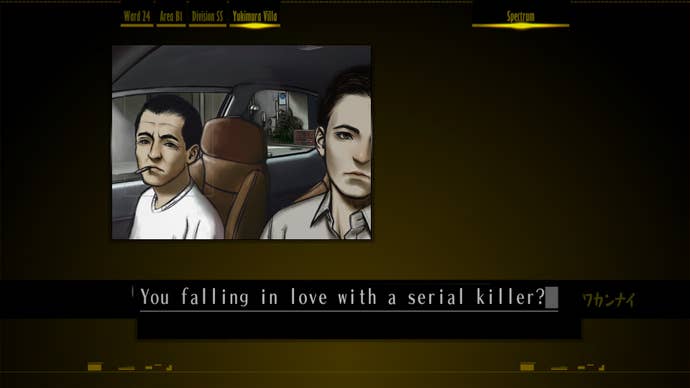Suda51 on The Silver Case and his Return to Subdued Visual Novels
One of gaming's most eccentric auteurs shares what it's like to revisit his first original game, its new chapters for the Playstation 4 remaster, and more.
This article first appeared on USgamer, a partner publication of VG247. Some content, such as this article, has been migrated to VG247 for posterity after USgamer's closure - but it has not been edited or further vetted by the VG247 team.
The Silver Case is a game of two halves. There’s the slightly pragmatic side, one written by Masahi Ooka, where the player is a journalist. And there’s the frenetic side by Goichi Suda (also known as the ever-recognizable Suda51), where the player controls a hard-boiled detective. These two halves make a whole, despite how disorienting that whole may be. The Silver Case’s split reflects its director's own sensibilities that have made him one of gaming’s renown auteurs—the Suda51 that’s not afraid to get dark, and the Suda51 that doesn’t shy from getting a little weird and silly too.
With a cursory glance at The Silver Case though, it’s hard to see it as a game directed and partially written by Suda51. It’s grim. It’s bleak. It’s a visual novel, and not an action game. But a closer look reveals otherwise. With its wieldy narrative and heavier themes of crime and violence seeping into the games you likely know well as Suda51 joints, even in the ones with a tinge of brightness. Last October, the 1999 Grasshopper Manufacture game was remastered for release on Steam—the first time the game saw a Western audience. On April 18, 2017 in North America (and April 21, 2017 in Europe) the game will host another release on the Playstation 4, but this time with a twist: it will have two newly written additional chapters, each by Suda51 and his colleague Ooka.
In my meeting with Suda51, he’s wearing a shirt with an image from the game’s mobile-bound sequel, The Silver Case: Ward 25, emblazoned onto it. When I ask him if that sequel is more firmly planned for a potential remaster, he gestures at the blood-tinged image residing on his chest, “Absolutely, that’s why I’m wearing this t-shirt!” In a way, The Silver Case is what paved the the way for Suda51's eccentric career, giving him a break from other IP-owned properties, and letting his wild imaginition run rampant for the very first time. The Silver Case laid the stepping stones to the what-the-f**k-that's-weird-but-dope mastery that oozes in everything Suda51 nearly touches, and the coolness that emanates from him like an invisible carbon monoxide leak when he merely steps onto a stage. With such a legacy in his wake, Suda51 is now taking a step back and returning to the game that made him who he is. So we talked to him about it.

USgamer: Since The Silver Case is the first game from Grasshopper and your style has evolved to more action-focused games since then, what led to you revisiting your visual novel, and what was looking back to that genre of game like?
Suda51: One thing is that this game actually never came out in the West, and I really wanted everybody to be able to play it. So revisiting it and having that opportunity to bring it out to everybody, which had never been done before, was something I really wanted to do. That’s kinda where the idea originally came from.
From a timing perspective, it feels like it couldn’t have been better. Visual novels now are becoming more popular over here. You’ve got indie creators working on visual novels. So the timing really couldn’t be better for people to play it. Especially maybe younger fans, who weren’t around when the game originally came out.
USG: For the PS4 release, you mentioned that there are going to be two additional chapters that weren’t in the Steam remaster from last fall. Given that you developed this game nearly twenty years ago, what was it like reinhabiting your younger self in a creative way, or did you see your present self bringing in your current experiences back into it?
S51: Specifically, there’s two parts of [The Silver Case]: there’s “Transmitter” and there’s “Placebo.” The person who wrote the “Placebo” side is a man named Mr. [Masahi] Ooka. What we did this time is we gave him all the text from the old game. We gave him the game and he played it again, he read through everything again. I feel like Mr. Ooka installed his old self of when he was that age [by] writing it into himself again when he wrote the new part.
When the planning for this game first came about, it was when I worked at my previous employer, Human Entertainment. There was about a year between when I knew I was gonna make The Silver Case and when it actually [started]. Within that, as I was writing things, every chapter or part took about 3-4 weeks, almost a month to do. It just physically took that long to do. And I had to spend a lot of time throwing myself completely into it. And this time, as I wrote my new chapter for the game, part of it was a rehabilitation for myself, to get used to it. Part of it was, as I mentioned earlier about Mr. Ooka, installing that into myself again. And I plan to continue the story even further, beyond what I’ve already added additionally in the new chapter. So I see that as a training to get ready for that, as well as building up my muscles one more time to really write a visual novel because it takes so much out of you to do so.
USG: Both thematically and stylistically, The Silver Case is kind of where your unique visual style began to blossom. Even though you’ve grown as a developer in the years since, what thread have you seen remaining?
S51: The Silver Case is the first game I made as an independent creator, and it’s a game about crime. It’s dark. After that, I feel like I made the complete opposite in Flower, Sun, and Rain. You’re at a resort. There’s all this sunshine. It’s beautiful, it’s nice. And then again, that pendulum, switched all the way to the opposite side again with Killer 7, where, again, it’s dark, it’s about crime, it’s about all these things. And then after creating that, I felt like I went back to the other side again. I wanted to create a game that’s more fun, more silly, so you have something like No More Heroes. So what you could say The Silver Case did was to set that pendulum in motion. To go, okay let’s go over here now, but now I want to go over here, and to go back there. That’s where The Silver Case lies in all that.

Also to kind of expound upon that a bit, The Silver Case was the first game I made as an independent creator, meaning it’s original. Whereas the games I worked on before at Human, they were IP owned by that company, but now it’s my very own. The actual act, or the process itself of creating and writing and making all that, created a big energy going forward. So that also contributed to everything else that came after, getting the confidence to do something like that, the undertaking of creating something brand new and original.
USG: Beyond these remasters, do you see yourself going back to the subdued, visual novel-style of games?
S51: In a word, yes. What we want to do is continue, as we mentioned earlier, with Ward 25. We’re working with another company called AGM, Active Gaming Medium, who worked on the PC version of this game and did all the programming and things like that. There’s them, our company (Grasshopper Manufacture), and NIS America. It’s us three working together trying to allow this to become a series. To continue writing and working on this world, it’s obviously partially dependent on sales and things like that too, but being able to do that and turn this into a series going forward is something we strongly hope we can make happen.




